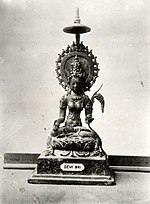| This article is a part of the series on |
| Indonesian mythology and folklore |
|---|
 |
Hantu is the Malay and Indonesian word for spirit or ghost. [1] In modern usage it generally means spirits of the dead but has also come to refer to any legendary invisible being, such as demons. [2] In its traditional context the term also referred to animistic nature spirits or ancestral souls. [3] The word is derived from Proto-Malayo-Polynesian *qanitu and Proto-Austronesian *qaNiCu. Cognates in other Austronesian languages include the Micronesian aniti, Lio language nitu, Yami anito, Taivoan alid, Seediq and Atayal utux, Bunun hanitu or hanidu, Polynesian aitu or atua , and Tsou hicu among the Formosan languages. [4] [5] In terms of concept and place in traditional folklore, it is most similar to the Filipino anito.